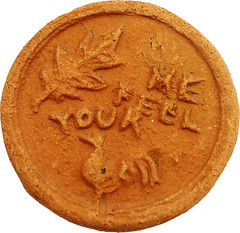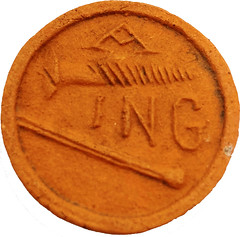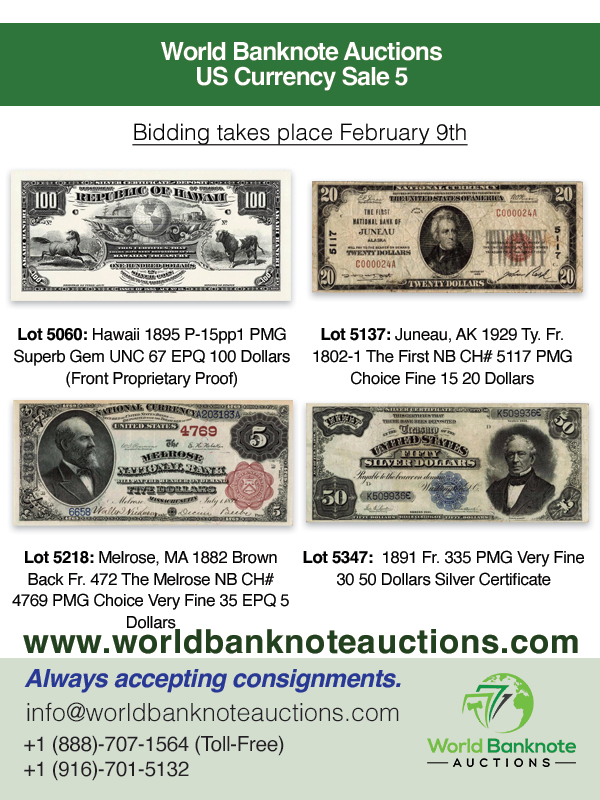
We've periodically highlighted the interesting and unusual numismatic work of George E. Ohr - his six "double-sided clay coins bearing pictures, words, and numbers combined to form twelve messages, all crudely sexual."
A new Smithsonian article delves into Ohr's history and a new museum showcasing his pottery work.
-Editor
Just a few blocks from shore, a five-story wooden pagoda labeled BILOXI ARTPOTTERY towered above the train tracks that ran across Delauney Street. Approaching it, a visitor saw hand-lettered signs. One read: Get a Biloxi Souvenir, Before the Potter Dies, or Gets a Reputation. Another proclaimed: Unequaled unrivaled—undisputed— GREATEST ARTPOTTERON THE EARTH. Stepping inside, a curious tourist found a studio overflowing with pots. But they were not your garden variety. These pots featured rims that had been crumpled like the edges of a burlap bag. Alongside them were pitchers that seemed deliberately twisted and vases warped as if melted in the kiln. And colors! In contrast to the boring beiges of Victorian ceramics, these works exploded with color—vivid reds juxtaposed with gunmetal grays; olive greens splattered across bright oranges; royal blues mottled on mustard yellows. The entire studio seemed like some mad potter's hallucination, and standing in the middle of it all was the mad potter himself.
 Viewed from a distance across his cluttered shop, George Ohr didn't look mad. With his huge arms folded across his dirty apron, he looked more blacksmith than potter. But as they got a bit closer, customers could glimpse the 18-inch mustache he had wrapped around his cheeks and tied behind his head. And there was something in Ohr's eyes—dark, piercing and wild—that suggested, at the very least, advanced eccentricity. If the pots and the man's appearance did not prove lunacy, his prices did. He wanted $25—the equivalent of about $500 today—for a crumpled pot with wacky handles.
Viewed from a distance across his cluttered shop, George Ohr didn't look mad. With his huge arms folded across his dirty apron, he looked more blacksmith than potter. But as they got a bit closer, customers could glimpse the 18-inch mustache he had wrapped around his cheeks and tied behind his head. And there was something in Ohr's eyes—dark, piercing and wild—that suggested, at the very least, advanced eccentricity. If the pots and the man's appearance did not prove lunacy, his prices did. He wanted $25—the equivalent of about $500 today—for a crumpled pot with wacky handles. No two alike, he boasted, but to most customers each looked as weird as the next. No wonder that as the new century began, thousands of the colorful, misshapen works collected dust on Ohr's shelves, leaving the potter mad, indeed, at a world that failed to appreciate him. I have a notion . . . that I am a mistake, he said in an interview in 1901. Yet he predicted, When I am gone, my work will be praised, honored, and cherished. It will come.
Some 85 years after his death, the self-styled Mad Potter of Biloxi will be praised and honored as he predicted. Two years from now, Ohr's startling ceramics will be showcased in a new $25 million Biloxi arts center designed by architect Frank O. Gehry, whose swirling silver Guggenheim Museum put Bilbao, Spain, on the cultural map. The Ohr-O'Keefe Museum of Art, a Smithsonian Affiliate, is named in honor of former Biloxi mayor Jeremiah O'Keefe and his late wife, Annette. Their family's $1 million gift helped establish the museum, now housed in a small building downtown, in 1998.
The new facility, scheduled to be completed in January 2006, will be nestled in a four-acre grove of live oaks overlooking the Gulf. As America's first museum dedicated to a single potter, the complex will call attention to an art more often seen as craft. And if yet another story of an artist ahead of his time sounds clichéd, the resurgence of George Ohr will cap one of the art world's most remarkable comebacks. For although his work is now in such museums as New York's Metropolitan Museum of Art and the Smithsonian's National Museum of American History, until the late 1970s, the only place to see an Ohr pot was in a garage behind a Biloxi auto shop—in a crate.
in both museum and private collections, nearly every Ohr pot is dated to the same short period: 1895-1905. During this decade, Ohr labored at a feverish pace, turning out thousands of amazing, outrageous, wonderful pots. Just as Cézanne was breaking up the plane of the painter's canvas, Ohr was shattering the conventions of ceramics. He made pitchers whose open tops resembled yawning mouths. He threw slim, multitiered vases with serpentine handles. He lovingly shaped bowls into symmetrical forms, then crumpled them as if to thumb his nose at the art world. He fired his works into kaleidoscopic colors that only a few years later would be called fauve—for the wild hues of Matisse and other Fauvists. And almost a decade before the Cubists added print to their canvases, Ohr scrawled on his ceramics with a pin.
Locals were not amused, and many considered their native mud dauber certifiably insane. More likely, Ohr was just ahead of his time, in promoting his work as well as crafting it. Decades before Salvador Dali began his self-aggrandizing antics, Ohr asked a reporter, You think I am crazy don't you? Assuming a sober demeanor, the mad potter confided, I found out a long time ago that it paid me to act this way. It did not pay well, however. Ohr was a notoriously bad businessman. He put shockingly high prices on his favorite pots because he simply could not bear to part with them. On those rare occasions when customers paid the asking price, Ohr would chase them down Delauney Street, trying to talk them out of the purchase. Ohr didn't seem to care that he made so little money. Every genius is in debt, he said.
By the turn of the century, Ohr had begun to get a little respect if not much success. Asurvey of ceramics published in 1901 called his body of work in some respects, one of the most interesting in the United States. Although Ohr exhibited his pots around the country and in Paris, the prizes always went to more traditional pottery. Ohr's only medal, a silver for general work, came at the 1904 Louisiana Purchase Centennial Exhibition in St. Louis. Still, he did not sell a single piece there. Even his few admirers misunderstood him.
See the complete article online for more, including how antiques dealer James Carpenter purchased Ohr's unsold inventory.
-Editor
After three more summers of negotiations, for a price rumored to be closer to the lower figure, Carpenter moved Ohr's treasures to New Jersey, where they began trickling onto the marketplace.
 Meanwhile, the art world had begun catching up to Ohr. During the 1950s, a school of Abstract Expressionist ceramics had flowered, creating free-form works that looked more like sculpture than pottery. Artists, including Jasper Johns and Andy Warhol, bought Ohr's pots, as did several collectors, though the curator of ceramics at the Smithsonian's National Museum of American History protested Ohr's inclusion in a show in 1978, calling him
Meanwhile, the art world had begun catching up to Ohr. During the 1950s, a school of Abstract Expressionist ceramics had flowered, creating free-form works that looked more like sculpture than pottery. Artists, including Jasper Johns and Andy Warhol, bought Ohr's pots, as did several collectors, though the curator of ceramics at the Smithsonian's National Museum of American History protested Ohr's inclusion in a show in 1978, calling him just plain hokey.
Only in 1984, when Ohr pots appeared in paintings by Johns at New York's Leo Castelli Gallery, did praise and critical esteem begin to flow. After a series of one-man shows of Ohr's work, collectors such as Steven Spielberg and Jack Nicholson purchased pieces and drove prices up. Today, the same pots scorned a century ago sell from $20,000 to $60,000 each. Back in 1900, when his pots were barely selling at all, exasperated exhibition organizers would ask Ohr to put a value on his works. Worth their weight in gold, he would answer. In retrospect, he sold himself short.
To read the complete article, see:
The Mad Potter of Biloxi
(https://www.smithsonianmag.com/arts-culture/the-mad-potter-of-biloxi-106065115/)
To read the earlier E-Sylum article, see:
GEORGE OHR'S PROVOCATIVE CLAY TOKENS
(https://www.coinbooks.org/v24/esylum_v24n50a23.html)
NUMISMATIC NUGGETS: MAY 7, 2023 : George Ohr Token
(https://www.coinbooks.org/v26/esylum_v26n19a24.html)
Wayne Homren, Editor
The Numismatic Bibliomania Society is a non-profit organization
promoting numismatic literature. See our web site at coinbooks.org.
To submit items for publication in The E-Sylum, write to the Editor
at this address: whomren@gmail.com
To subscribe go to: https://my.binhost.com/lists/listinfo/esylum
Copyright © 1998 - 2023 The Numismatic Bibliomania Society (NBS)
All Rights Reserved.
NBS Home Page
Contact the NBS webmaster
|






